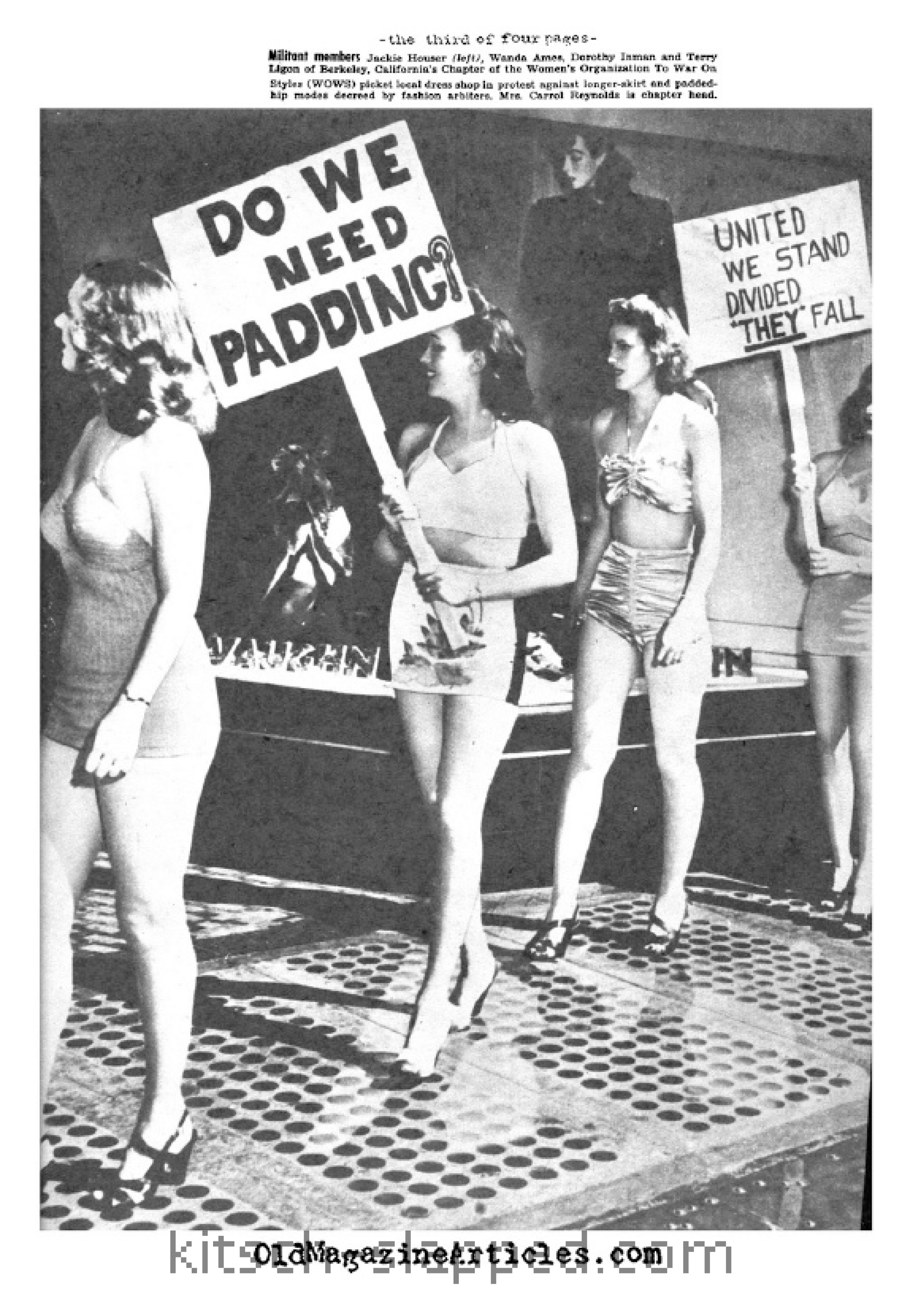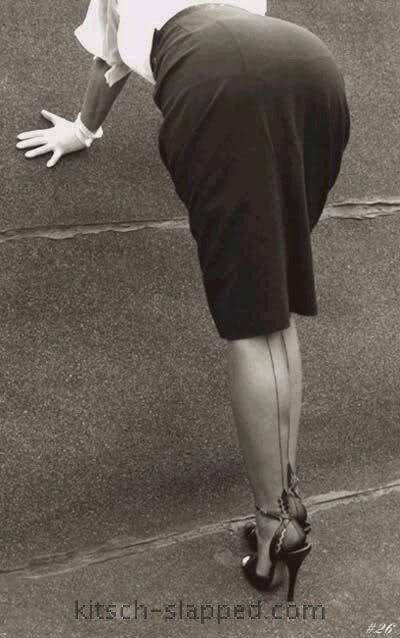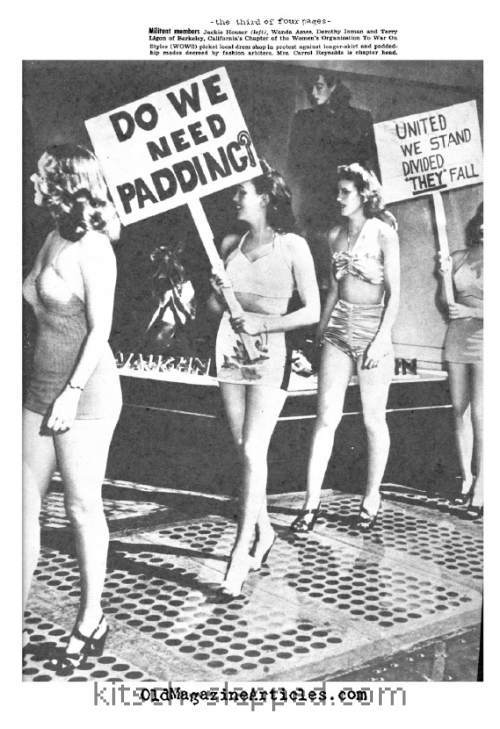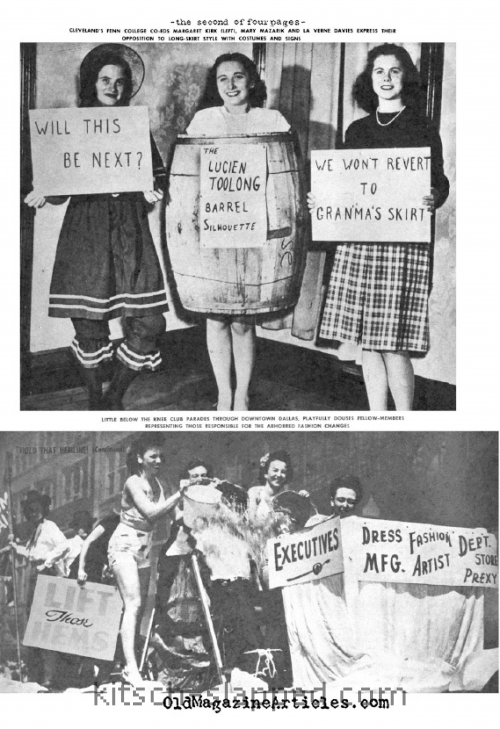At my vintage living blog, Things Your Grandmother Knew, I’ve written about the tendency to romanticize the past, but I recently read two blog posts discussing vintage fashion in terms of “the vintage girl being the new feminist” and thought it was time to discuss the subject from a more feminist angle…
At Style High Club, Lena Weber writes:
I don’t quite know how it happened or when but far too many women around me seem to want to look like a porn actress these days. Or why else would they wax off their pubes, slather themselves in Fakebake and state Page Three Girl in their career goals? There is something about the passivity of this particular idea of femininity – there to be stared at, cum onto – that I find deeply infuriating. It’s just sad that we’re all meant to look like little plastic sex dolls – fake eyelashes, fake hair, fake tan, fake boobs.
To my relief (no really, it is!) there is a great big social group of women out there who don’t buy into this image – the vintage girls. Although the vintage scene is splintered into smaller subfractions of particular decades, musical styles, dances and activities, the one thing all these vintage-loving women have in common is their embrace of an altogether different femininity, one that’s individual, one that harks back to a time when glamour was exotic and empowering.
At Retro Chick, Gemma Seager responds with something I was eager to point out:
It’s easy to say that this isn’t new, 1950s Pin Ups weren’t exactly sold on their educational qualifications, and the idea of a woman whose goal was to marry a rich man and live happily ever after is hardly a new concept either. That’s why we had the “bra burning” feminists of the 60s and 70s. They stood up for the rights of women to be whatever they wanted to be.
But then Seager heads right down Weber’s path:
In the last 2 decades the internet has seen a progressive pornification of culture till it seems that women now feel that they can’t assert their own sexual independence, that they have no choice but to buy into this porn star, brainless ideal of female beauty and passive sexuality. They are modern day Stepford Wives, emotionally passive and sexually compliant. Brainwashed by television, magazines and the internet into thinking they can’t make emotional demands and that sexual liberation means always wanting to have sex.
Maybe it’s because I am (I’m pretty sure) at least a decade older than these women, or maybe it’s because I am a history nut who gets obsessed with research, but I’m thinking that these two women (and the majority of those who have commented at their sites) are missing something quite important from all of this. And that something is context.
If we look at “today” and compare it to the past, yes, women’s fashions seem to be much more skimpy. [Until, at least, you notice how a New Look wiggle dress is as fitted as any spandex dress — and realize that beneath that vintage wiggle dress or pencil skirt there’s a whole lot of foundation garments making sure the female figure is as hourglass, smooth, and popping (eye-popping and fabric-testing), and as it can be. More on that later.]
Every generation has declared the next one will be the ruin of fashion, morals, and even civilization. In fact, every decade and fashion trend has resulted in criticism — often for the wearer too. Hemlines went up and dared to show ankles — so women could dare to ride bikes! That may seem antiquated to us now, so let’s look at the styles and decades that most vintage fashionistas wear, such as New Look and Mod.
When New Look fashions hit the market, they were not applauded. In Popularizing Haute Couture: Acceptance and Resistance to the New Look in the Post-1945 United States (Americanist: Warsaw Journal for the Study of the United States; October 2007, Vol. 24, p143), Sylwia Kuzma writes:
The New Look promoted a vision of femininity, epitomized in a full-bosom-and-curvaceously-hipped hourglass figure, dressed in lace, fur, and diamonds. Despite the patronage of large New York and San Francisco department stores, it’s reception by the American public was far from unanimous fascination and acceptance.
Some found the look too decadent to be seemly. Some were incensed that Dior’s New Look would require them to be padded. Others found the below-the-knee hemlines frumpy. (Images from a 1948 magazine via.)
A decade later, when the first babydoll nighties and dresses hit the scene, many found them obscene.
The point is, with every hemline, waistline, and neckline movement tongues go a-waggin’.
Today, Bettie Page is held up as a prime example of a cheeky risque pinup to be emulated and adored. She is such an icon for vintage fashion lovers, that many stores, designers, brands, websites, and events use the name Bettie to garner attention. But she’s The Notorious Bettie Page for a reason — her pinup photos were the subject of censorship and she herself was a target of a US Senate pornography investigation. The adoration of Bettie Page as “cute” and “classy” raises the ire of many, including sex workers — many of whom already feel shunned by feminism. To many, this co-opting of Page for “good girls” is a theft they won’t stand for.
Which brings us to the matter of vintage glamour being “exotic and empowering”…
Those are the very words many use to describe their sex work and to defend a sex positive or even “pornified” culture. In many ways, today’s sex workers and pornified pop culture icons control their bodies far more than the women of decades ago. The 1950’s woman put on an exaggerated-hourglass Dior dress to lure in Mr. Right for marriage. Once she “caught” her man, she put on a golden wiggle dress to serve cocktails to her husband’s boss; a pretty little prop in her husband’s life. When The Little Woman needed to be medicated in order to endure her life, her doctor talked to her husband-daddy, so he could make the decisions for her — as if she were a child. Does that seem glamorous, exotic, or empowering?
Wearing vintage fashions may be moving the hemlines, waistlines, and necklines back in time, but does that move women forward towards equality?
Yes, fashion sends messages about who we are — at least at that moment. But, ultimately, what defines a person is their actions. And if we start labeling and denigrating people for what they are wearing, then we are on a very slippery slope . This is especially true for women because of that whole “what she’s wearing is asking for rape” thing. Not to mention that whole “what does a feminist look like” argument that no body wins.
Our bodies belong to ourselves. We’ll dress them ourselves, to please ourselves, and we’ll be the kind of person we wish to be.




2 Comments